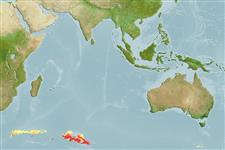Common names from other countries
Classification / Names / Names
Nomes comuns | Sinónimos | Catalog of Fishes (gen., sp.) | ITIS | CoL | WoRMS
Environment: milieu / climate zone / depth range / distribution range
Ecologia
Pelágico(a,os,as); intervalo de profundidade 457 - 3584 m (Ref. 89091), usually 747 - 2322 m (Ref. 89091). Polar
Antarctic Indian Ocean: Kerguelen Island.
Length at first maturity / Tamanho / Peso / Idade
Maturity: Lm ? range ? - ? cm
Depth range based on type locality; to be replaced with a better reference. Recorded in depths of 457 to 3150 m on the Kerguelen Plateau and only common between 747 and 2322 m (Ref. 89091).
Life cycle and mating behavior
Maturidade | Reprodução | Desova | Ovos | Fecundidade | Larvas
Members of the class Ostracoda are gonochoric. Sperm transfer is direct. During copulation, male clasps the female dorsally and posteriorly and later on injects its penis between the valves of the female. Eggs may either be attached to a substratum or brooded, where they grow and hatch as nauplii.
Ayress, M.A., P. De Deckker and G.P. Coles. 2004. (Ref. 89091)
Categoria na Lista Vermelha da IUCN (Ref. 130435)
Categoria CITES (Ref. 108899)
Not Evaluated
Not Evaluated
Ameaça para o homem
Harmless
Utilização humana
| FishSource |
Ferramentas
Mais informação
Nomes comunsSinónimosPredadoresReproduçãoMaturidadeDesovaFecundidadeOvosDesenvolvimento dos ovos
Idade/Tamanho
Crescimento
Comprimento-peso
Comprimento-comprimento
Morfologia
Larvas
Abundância
Fontes da internet
Estimates based on models
